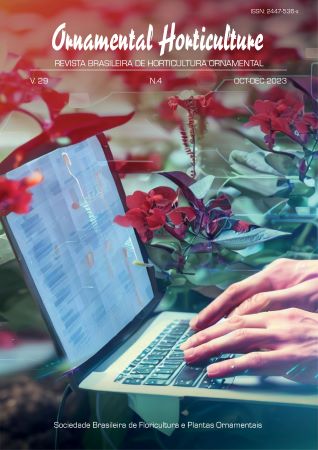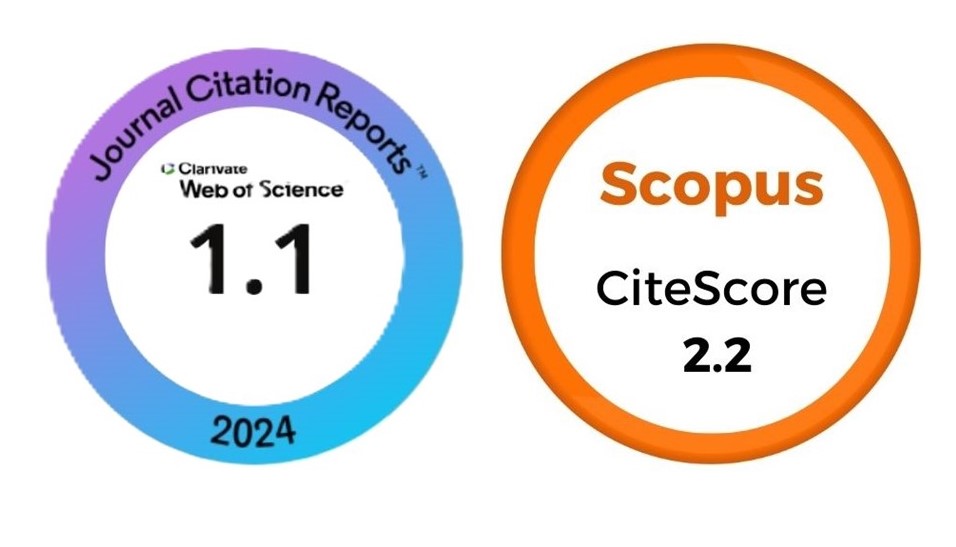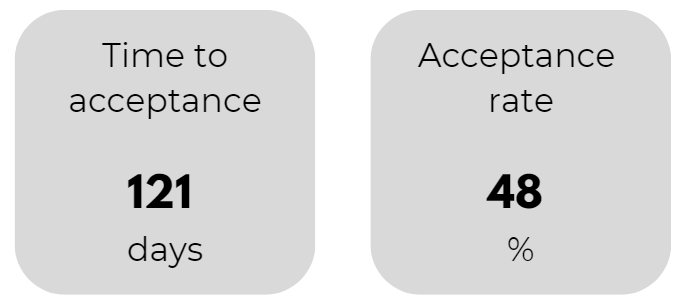Selection of desert rose accessions with high ornamental potential
DOI:
https://doi.org/10.1590/2447-536X.v29i4.2668Keywords:
desert rose, genetic variability, morphological markers, ornamental plantsAbstract
Adenium obesum belongs to the Apocynaceae family and is characterized as a succulent shrub with a multitude of botanical and morphological features of ornamental interest. The aim of this study was to evaluate the genetic dissimilarity of 28 accessions of A. obesum using morphological descriptors and multivariate techniques with the aim of pre-selecting the genotypes with the greatest ornamental potential. The distribution of the number of flowers throughout the year showed two flowering peaks in January and September. Twenty-one petal pigmentation patterns were identified, and 50% of the accessions had double-petal arrangement. The Gower’s algorithm and the UPGMA-generated dissimilarity matrix indicated the formation of three groups. While Tocher’s clustering method separated the accessions into eight groups showing greater ability to distinguish the evaluated genotypes. In conclusion, the multivariate analyses applied were effective in accessing the genetic diversity among the 28 accessions evaluated. The accessions ICA001, ICA005, ICA006, ICA018, ICA019, and ICA027 were preselected to compose the germplasm collection due to their high ornamental potential.
Downloads
References
ANDRADE, M.C.; FERNANDES, A.C.M.; SIQUEIRA, L.; TAMBARUSSI, E. V. The use of genetic distance and grouping methods to predict Eucalyptus pellita F. Muell genitors for hybridization. Cerne, v.26, n.3, p.414-426, 2020. https://doi.org/10.1590/01047760202026032744
AZIMI, M.H.; ALAVIJEH, M.K. Morphological traits and genetic parameters of Hippeastrum hybridum. Ornamental Horticulture, v.26, n.4, p.579–590, 2020. https://doi.org/10.1590/2447-536X.v26i3.2153
CORBESIER, L.; VINCENT, C.; JANG, S.; FORNARA, F.; FAN, Q.; SEARLE, I.; UNTIS, A.G.; FARRONA, S.; GISSOT, L.; TURNBULL, C.; COUPLAND, G. FT protein movement contributes to long-distance signaling in floral induction of Arabidopsis. Science, v.316, p.1030- 1033, 2007. https://doi.org/10.1126/science.1141752
CRUZ, D.C.; REGAZZI, J.A. Análise Multivariada Aplicada. Viçosa: Editora UFV, 2020. 408p.
FALEIRO, F.G.; FARIAS NETO, A.L.; RIBEIRO JUNIOR, W.Q. 2008. Pré-melhoramento, melhoramento e pós- melhoramento: estratégias e desafios. Available at: ˂http://www.alice.cnptia.embrapa.br/alice/bitstream/doc/562158/1/faleiro02.pdf˃ Acessed on: August 25th 2022.
GAARSLEV, N.; SWINNEN, G.; SOYK, S. Meristem transitions and plant architecture learning from domestication for crop breeding. Plant Physiology, v.187, n.3, p.1045-1056, 2021. https://doi.org/10.1093/plphys/kiab388
GOWER, J.C. A general coefficient of similarity and some of its properties. Biometrics, v.27, p.857-874, 1971.
LIRA, E.P.J.; SANTOS, A.A.C.; OLIVEIRA, A.J.; OLIVEIRA, E.P.; GALBIATI, C.; POLETINE, J.P.; NEVES, L.G.; BARELLI, M.A.A. Uso do algoritmo de Gower na determinação da divergência genética entre genótipos de Carthamus tinctorius L. Research, Society and Development, v.11, n.3, p.1-8, 2022. http://dx.doi.org/10.33448/rsd-v11i8.30044
MACHADO, F.C.; NASCIMENTO DE JESUS, F.; SILVA, A.C. Divergência genética de acessos de maracujá utilizando descritores quantitativos e qualitativos. Revista Brasileira de Fruticultura, v.37, n.2, p.442-449, 2015. https://doi.org/10.1590/0100-2945-110/14
MENDES, B.R.; ALMEIDA, A.F.E.; VENDRAME, W.; PAIVA, P.D.O. Manejo da cultura. In: NIETSCHE, S.; ALMEIDA, F.A.E.; MENDES, B.R. Cultivo e Manejo da Rosa do Deserto. São José dos Pinhais: Brazilian Journals, 2021. p.122-138.
MOJENA, R. Hierarquical grouping method and stopping rules: an evaluation. The Computer Journal, v.20, p.359- 363, 1977.
NARBONA, E.; DEL VALLE, J.C.; WHITTALL, J.B. Painting the green canvas: how pigments produce flowers colours. Biochemist, v.43, n.3, p.6-12, 2021. https://doi.org/10.1042/bio_2021_137
PNUELI, L.; CARMEL-GOREN, L.; HAREVEN, D.; GUTFINGER, T.; ALVAREZ, J.; GANAL, M.; ZAMIR, D.; LIFSCHITZ, E. The self-pruning gene of tomato regulates vegetative to reproductive switching of sympodial meristems and is the ortholog of CEN and TFL1. Development, v.125, n.11, p.1979-1989, 1998. https://doi.org/10.1242/dev.125.11.1979
R CORE TEAM R: A language and environment for statistical computing. R Foundation for Statistical Computing, Vienna, 2021. https://www.R-project.org/.
RAMOS, S.M.B.; CARVALHO, M.A.S.; POSSOBOM, C.C.F.; ALMEIDA, E.F.A.; NIETSCHE, S. Biology and structure of flowers in Adenium obesum (Forssk.) Roem. & Schult. (Apocynaceae) accessions with notes on the significance of these features for floriculture. Brazilian Journal of Botany, v.45, p.689-702, 2022. https://doi.org/10.1007/s40415-022-00804-5
RHS. Royal Horticultural Society colour chart., London: Vincent Square, 1995.
SALGOTRA, R.K.; CHAUHAN, B.S. Genetic diversity, conservation, and utilization of plant genetic resources. Genes, v.14, n.1, p.174-194, 2023. https://doi.org/10.3390/genes14010174
SANTOS, C.A.; LOUREIRO, G.A.H.A.; GOMES JÚNIOR, G.A.; PEREIRA, R.A.; SODRÉ, G.A.; BARBOSA, R.M. Seed germination and development of desert rose seedlings (Adenium obesum Roem. & Schult) on different substrates. Ciencia Rural, v.50, n.12, p.1-7, 2020. https://doi.org/10.1590/0103-8478cr201190691
SINGH, A.; CHAVAN, S.; BHRI, A.J.; PAREKH, V.; SHAH, H.P.; PATEL, B.N. New multipetalous variety G.Ad. 1 of Adenium obesum. International Journal of Current Microbiology and Applied Science, v.8, n.2, p.197-203, 2019. https://doi.org/10.20546/ijcmas.2019.807.025
SWARUP, S.; CARGILL, E.J.; CROSBY, K.; FLAGEL, L.; KNISKERN, J.; GLENN, K.C. Genetic diversity is indispensable for plant breeding to improve crops. Crop Science, v.61, p.839-852, 2021. https://doi.org/10.1002/csc2.20377
TYRACH, A.; HORN, W. Inheritance of flower colour and flavonoid pigments in Gerbera. Plant Breeding, v.116, n.4, p.377–381, 1997. doi:10.1111/j.1439-0523.1997.tb01015.x
VALADARES, R.N.; NÓBREGA, D.A.; LIMA, L.B.; MENDES, A.Q.; SILVA, F.S.; MELO, R.A.; MENEZES, D. Genetic divergence among eggplant genotypes under high temperatures. Horticultura Brasileira, v.37, n.3, p.272-277, 2019. http://dx.doi.org/10.1590/S0102-053620190304
Downloads
Published
Issue
Section
License
Copyright (c) 2023 Ornamental Horticulture

This work is licensed under a Creative Commons Attribution 4.0 International License.








